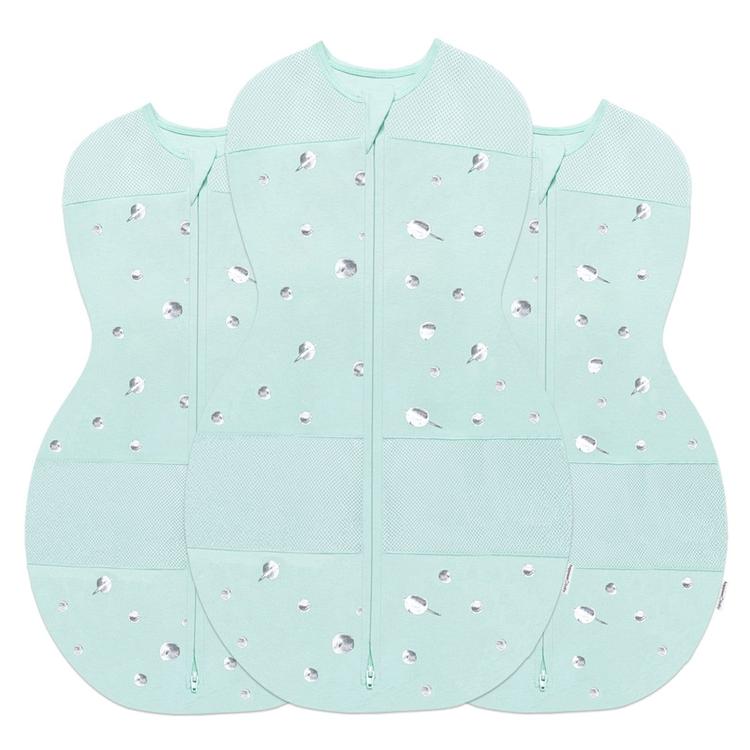Is my baby getting enough milk? How often should my baby eat? If you have had a baby for the first time—or the first time in several years—it is common for many waves of feeding questions to flood your mind.
Babies only have a few basic jobs: eat, sleep, poo, and be cute. To help them do their jobs well, it is essential for parents to understand the whys, hows, dos, and do-nots of baby feeding. Though every baby has their own unique needs, this guide will help you feed your baby throughout their first year of life.
Why Babies Eat So Often
Visualising the size of a baby’s stomach helps give a better understanding of their eating patterns. Babies frequently eat because they are developing rapidly and need good nutrition to support all that growth. They also eat often because their stomachs can only hold so much breastmilk or formula.
Here is how big your baby’s stomach is (for comparison, an adult’s stomach is about the size of a softball!):
- Day 1: marble-sized
- Day 3: ping-pong-ball-sized
- Day 7: plum- or apricot-sized
- One month old: large chicken egg-sized
How to Tell If Your Baby Is Hungry or Full:
Though we anticipate teaching our children everything they know, we sometimes fail to realise that we can also learn from them. One thing that babies can teach adults is how to listen to their bodies. As adults, it is easy for us to override our bodies’ cues for hunger and fullness (think of how you might feel after a holiday dinner). Babies have an impressive ability to regulate their hunger and fullness cues.
Your baby is a long way from saying 'more' and 'all done', however, they still communicate with you by showing signs of hunger and fullness. Both breastfed and formula-fed babies show signs of hunger and fullness, though breastfed infants may show more cues.
Some signs your baby is hungry in their first few months are:
- Bringing hands to mouth
- Puckering or smacking lips
- Turning head to look for a nipple (rooting)
- Tightening hands, arms, and body
Some signs your baby is full in their first few months are:
- Turning head away from breast or bottle
- Closing or sealing lips
- Relaxed hands, arms, and body
If your baby was born prematurely, they might show hunger and fullness cues differently from full-term babies. Talk with your baby’s paediatrician about feeding your premature baby.
The Best Way to Feed Your Baby
Whether breastfeeding or formula-feeding, the ultimate way to provide your baby with the milk they need is responsive feeding. Responsive feeding means you are feeding your baby by responding to their hunger and fullness cues instead of relying on a clock to dictate when it is time for a feeding.
Responsive feeding gives your baby a greater chance of growing optimally. It also builds trust and helps develop a healthy bond between you and your baby.
Formula-fed infants are at risk of being overfed. Overfeeding happens because of improper formula mixing, bottle propping, or force-feeding. Responsive feeding reduces these risks. If your baby is breastfed, you will not have to be worried about overfeeding. Nursing infants cannot overeat.
How to Know Your Baby Is Getting Enough Milk
For babies who nurse at the breast, it can be stressful for parents to not know how many millilitres of breastmilk their baby is taking at a time. If your baby is formula-fed, you may know exactly how much formula they take at feedings…but you still may wonder if they are getting what they need.
Signs your baby is getting enough milk:
- Baby is generally happy after feedings.
- Baby has frequent wet and dirty nappies.
- The paediatrician says baby is growing well.
How to Tell If Your Baby Needs More Milk
Usually, your baby gets hungry every two hours, but suddenly they want to nurse or take formula every half hour! What happened? If your baby seems to be hungrier or fussier than normal, they may be experiencing a growth spurt.
Though every baby is different, there is a typical timeline for growth spurts:
- 2-3 weeks
- 6 weeks
- 3 months
- 6 months
There may also be times your baby wants to nurse back-to-back. You nursed your baby 15 minutes ago, and now they are rooting again. This is called cluster feeding, and it is completely normal. Breastmilk or formula amounts needed will vary by baby, so follow your baby’s lead to know when to offer more milk.
Newborn Feeding Schedule
Newborn babies need breastmilk or iron-fortified infant formula to thrive. Some caregivers choose to provide both breastmilk and iron-fortified infant formula depending on the needs of the baby and the family.
Newborn Feeding Schedule for Breastfed Babies
Since newborn babies have such tiny bellies, they may breastfeed every 1 to 3 hours. Frequent breastfeeding is essential for your body to make more breastmilk. Breastfeed your baby 8 to 12 times each day to maintain a solid milk supply.
Newborn Feeding Schedule for Formula-Fed Babies
If bottle-fed, babies may take anywhere between 30 and 90 ml at feedings every 2 to 3 hours. Since every baby is different, always seek the guidance of your baby’s paediatrician if you have any concerns or questions.
Baby Feeding Schedule: 1 to 3 Months
Feeding Schedule for Breastfed Babies
By now, your baby has grown skilled at breastfeeding and may get milk more efficiently than they used to! Your baby may eat less frequently than they did in the newborn stage, but it is still important to offer breastmilk as often as your baby needs to nurse at least eight times daily.
Feeding Schedule for Formula-Fed Babies
Your formula-fed infant may be taking 120-150 ml of formula every 3 to 4 hours starting around 2 months of age. Around this age, family members may try to persuade you to offer your baby cereal in the bottle. Babies are too young for infant cereal and other foods at this age and still require a 100% breastmilk or formula diet. Giving solids at this age to help babies sleep through the night is a myth and can actually harm your baby. Hold off on introducing other foods for a bit longer because starting solids is just around the corner!
Baby Feeding Schedule: 4 to 6 months
Feeding Schedule for Breastfed Babies
You and your little one have likely established an excellent breastfeeding rhythm at this point. It is recommended to continue following your baby’s hunger and fullness cues and breastfeed on demand. The NHS recommends continuing exclusively breastfeeding and waiting to start solids until 6 months.
Feeding Schedule for Formula-Fed Babies
Formula-wise, your lovebug may have graduated to greater formula amounts by now. Babies may take 120-180 ml of formula as needed. Though every baby is different and may require more or less formula at a feeding, the general rule of thumb is that they should take 150-200 ml of formula per kg of body weight each day. So, if you have a 6,5 kg baby, they might be taking over 1000 ml of formula in 24 hours.
Signs of Readiness for Solids
Around 4 to 6 months, babies may begin to show signs of readiness for solids. If you have concerns about starting solids with your baby, always consult with your baby’s paediatrician.
When your kid shows signs they are ready for solids, it is a great time to excite their palates with a few tastes of single-ingredient purees.
Signs of readiness for starting solids:
- Baby can sit up on their own for at least a minute.
- Baby is interested in foods.
- Baby opens their mouth when presented with a spoon.
- Baby closes mouth over the spoon and pulls foods off the spoon.
- Baby grabs at food.
Depending on the baby, these signs of readiness will show up anywhere between months 4, 5, or 6. When your baby is ready for solids, you will know! Offer single-ingredient solids every three days to make sure there are no food allergies.
Baby Feeding Schedule: 6 to 8 months
Feeding Schedule for Breastfed Babies
Continue breastfeeding your baby on demand. If you are pumping, you can offer breastmilk in a sippy cup with handles.
Feeding Schedule for Formula-Fed Babies
On average, formula-fed babies need 700-950 ml daily at this point since they also get nutrition through the solids you have introduced. This is a great time to consider offering formula in a sippy cup with handles.
Complementary Feeding
Though breastmilk and formula are still the top nutrition sources needed by babies, there is a new requirement for nutrition that comes from introducing solid foods. Below, you will find the nutrition needs for infants ages 6 to 8 months by food group.
At this age, your baby may be trying to grab food and toys with their whole hands. You can also start offering your baby 120-230 ml of plain water daily, which is recommended until 12 months of age.
Grains: 30-55 grams daily
- Infant cereals (barley, multigrain, oatmeal—avoid rice cereal)
- Soft bread and crackers
Fruits: 55-115 grams daily
- Mashed, strained, or pureed fruits such as bananas, apples, pears, prunes, and avocados
Vegetables: 55-115 grams daily
- Mashed, strained, or pureed vegetables such as carrots, peas, green beans, potatoes, and squash
Protein: 30-55 grams daily
- Mashed, strained, or pureed meat, poultry, fish, eggs, beans, lentils, cheese, and yogurt
Baby Feeding Schedule: 9 to 12 months
Feeding Schedule for Breastfed Babies
Congratulations on continuing to offer your baby breastmilk! You should feel proud of all you have done to provide your baby with these benefits. It is recommended to breastfeed until 12 months of age, but if everything is going well for you and your baby, you can feel free to breastfeed beyond your baby’s first year.
Feeding Schedule for Formula-Fed Babies
On average, babies this age need at least 700 ml of formula daily (they are also getting some nutrition through the solids you have been introducing). That 700 ml of formula might be divided into three 230 ml bottles or four 175 ml bottles throughout the day, depending on the baby.
Complementary Baby Feeding Schedule
By now, your baby is using their pointer finger and thumb to pick up smaller pieces of foods or finger foods. Below, you will find the nutrition needs for infants ages 9 to 12 months by food group.
Grains: 55-115 grams daily
- Infant cereals (barley, multigrain, oatmeal—avoid rice cereal)
- Bread, crackers, noodles, rice, corn, quinoa, grits, or soft pieces of tortilla
Fruits: 115-170 grams daily
- Chopped, diced, or ground fruits, such as bananas, apples, pears, peaches, and avocados
Vegetables: 115-170 grams daily
- Chopped, diced, or ground vegetables, such as carrots, peas, green beans, potatoes, and squash
Protein: 55-115 grams daily
- Shredded or cut up meat, poultry, fish
- Fork mashed beans
- Eggs, lentils, diced cheese, and yogurt
Foods to Avoid in the First Year of Life
- Cow’s Milk: Babies are not able to grow optimally on regular cow’s milk which lacks the nutrition babies need. Giving cow’s milk to babies can cause health problems and poor growth.
- Honey: Consuming honey at this age puts babies at risk for contracting illness from Clostridium botulinum which can cause severe illness and death.
- Choking Risks: Foods that can cause choking in infants include hot dogs, grapes, hard candies, nuts, seeds, popcorn, chunks of nut butter, sausages, gum, and bones.





















